Related Research Articles

Ares is the Greek god of war and courage. He is one of the Twelve Olympians, and the son of Zeus and Hera. The Greeks were ambivalent towards him. He embodies the physical valor necessary for success in war but can also personify sheer brutality and bloodlust, in contrast to his sister Athena, whose martial functions include military strategy and generalship. An association with Ares endows places, objects, and other deities with a savage, dangerous, or militarized quality.
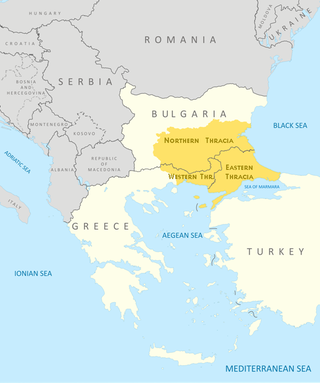
Thrace is a geographical and historical region in Southeast Europe. Bounded by the Balkan Mountains to the north, the Aegean Sea to the south, and the Black Sea to the east, it comprises present-day southeastern Bulgaria, northeastern Greece, and the European part of Turkey, roughly the Roman Province of Thrace. Lands also inhabited by ancient Thracians extended in the north to modern-day Northern Bulgaria and Romania and to the west into Macedonia.

In Greek mythology, Europa was a Phoenician princess from Tyre and the mother of King Minos of Crete. The continent of Europe is named after her. The story of her abduction by Zeus in the form of a bull was a Cretan story; as classicist Károly Kerényi points out, "most of the love-stories concerning Zeus originated from more ancient tales describing his marriages with goddesses. This can especially be said of the story of Europa."

Aëdon was in Greek mythology, the daughter of Pandareus of Ephesus. According to Homer, she was the wife of Zethus, and the mother of Itylus. Aëdon features in two different stories, one set in Thebes and one set in Western Asia Minor, both of which contain filicide and explain the origin of the nightingale, a bird in constant mourning.
In Greek mythology, Biston was the son of Ares and Callirrhoe, daughter of river-god Nestus. His two brothers were Odomas and Edonus. Alternately, he was called son of Paeon and grandson of Ares. In some accounts, he was the son of either the Muses Terpsichorus or Calliope.
Telephassa, also spelled Telephaassa and Telephe, is a lunar epithet in Greek mythology that is sometimes substituted for Argiope the wife of Agenor, according to his name a "leader of men" in Phoenicia, and mother of Cadmus.
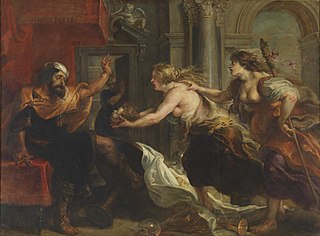
In Greek mythology, Tereus was a Thracian king, the son of Ares and the naiad Bistonis. He was the brother of Dryas. Tereus was the husband of the Athenian princess Procne and the father of Itys.
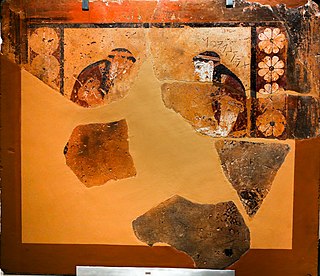
Philomela or Philomel is a minor figure in Greek mythology who is frequently invoked as a direct and figurative symbol in literary and artistic works in the Western canon.
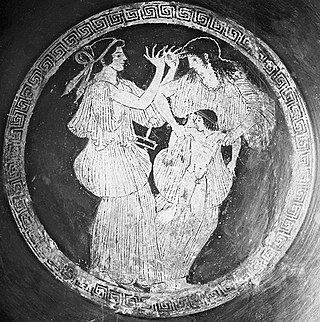
In Greek mythology, Itys is a minor mythological character, the son of Tereus, a king of Thrace, by his Athenian wife Procne. Itys was murdered by his own mother and served to be consumed during dinner by his father, as part of a revenge plan against Tereus over him assaulting and raping Philomela, Procne's sister. His immediate family were all transformed into birds afterwards, and in some versions Itys too joins them in the avian kingdom. Itys' story survives in several accounts, the most extensive and famous among them being Ovid's Metamorphoses. His myth had been known since at least the sixth century BC.

In Greek mythology, the name Melanippe referred to several different people:

Aegina was a figure of Greek mythology, the nymph of the island that bears her name, Aegina, lying in the Saronic Gulf between Attica and the Peloponnesos. The archaic Temple of Aphaea, the "Invisible Goddess", on the island was later subsumed by the cult of Athena. Aphaia (Ἀφαῖα) may be read as an attribute of Aegina that provides an epithet, or as a doublet of the goddess.
In Greek mythology, Harpalyce is a name attributed to four women.
Bistones is the name of a Thracian people who dwelt between Mount Rhodopé and the Aegean Sea, beside Lake Bistonis, near Abdera extending westward as far as the river Nestus. It was through the land of the Bistones that Xerxes marched on his invasion of Greece. The Bistones continued to exist at the time when the Romans were masters of Thrace. Roman poets sometimes use the names of the Bistones for that of the Thracians in general. Pliny mentions one town as belonging to the Bistones: Tirida; the other towns on their coast, Dicaea, Ismaron, Parthenion, Phalesina and Maronea, were Greek colonies.
In Greek mythology, Sithon was a king of the Odomanti or Hadomanti in Thrace, and presumably the eponym of the peninsula Sithonia and the tribe Sithones.

Procne or Progne is a minor figure in Greek mythology. She was an Athenian princess as the elder daughter of a king of Athens named Pandion. Procne was married to the king of Thrace, Tereus, who instead lusted after her sister Philomela. Tereus forced himself on Philomela and locked her away. When Procne discovered her sister and her gruesome fate, she took revenge against her husband by murdering their only child, a young boy named Itys. Procne's story serves as an origin myth for the nightingale.
In Greek mythology, Daulis and at a later stage Daulia and Daulion was the name of a mythological figure and Davleia, the city in Phocis, is named after her. Daulis was the hometown of Tereus, Thracian king and also the city at the end of the road not taken by Oedipus.
In Greek mythology, Dryas was a lord from Calydon who was also one of the famous Calydonian hunters.
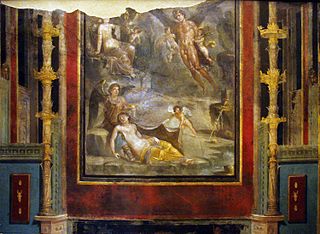
In Greek mythology, Chloris was a nymph/goddess who was associated with spring, flowers and new growth, believed to have dwelt in the Elysian Fields.
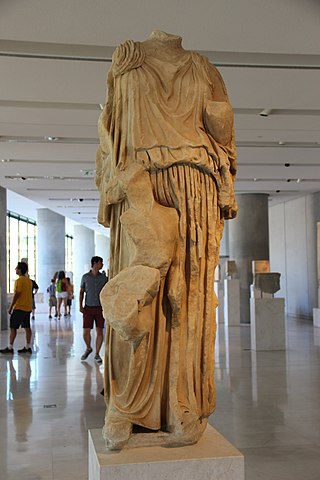
The statue of Procne and Itys is a Greek marble sculpture of the fifth century BC which once adorned the Acropolis of Athens, created by sculptor Alcamenes. The statue depicts the Athenian princess Procne about to strike her own son Itys dead as revenge against her husband Tereus. It was discovered near the temple of Athena-Nike during the early nineteenth century, and it is now exhibited in the Acropolis Museum of Athens, in Greece.
References
- ↑ THE MOURNING FOR BION.; TRANSLATED FROM THE GREEK OF MOSCHUS.JAMES GILBORNE LYONS The Knickerbocker; or New York Monthly Magazine (1833-1862); Dec 1849; 34, 6; APS Online
- MYTHOLOGY.; BELLONA. VICTORY. THE STORY OF TEREUS.
The Family Magazine; or, Monthly Abstract of General Knowledge (1833-1841); Apr 1835; 2, APS Online pg. A103